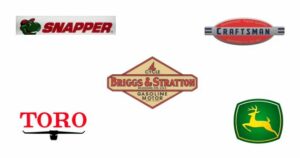In the wake of World War II, the United States saw a paradigm shift. As soldiers returned home, families grew, and so did the great American suburban dream. Front yards and backyards alike became emblems of this new way of life. And as the desire for manicured lawns took root, so did the need for innovations that made mowing more efficient and user-friendly. This is the story of mower evolution, the blending of technological advancements with America’s changing lifestyle aspirations.
 Riding Into the Future: The vast suburban landscapes of the 1950s were both a challenge and an opportunity. Traditional push mowers, while functional, were hardly efficient for these sprawling green spaces. Recognizing this, manufacturers like John Deere and Craftsman developed riding mowers. This innovation was more than just functional—it added a tinge of enjoyment to the chore of mowing. John Deere’s memorable “Nothing runs like a Deere” slogan became emblematic of this newfound blend of function and fun.
Riding Into the Future: The vast suburban landscapes of the 1950s were both a challenge and an opportunity. Traditional push mowers, while functional, were hardly efficient for these sprawling green spaces. Recognizing this, manufacturers like John Deere and Craftsman developed riding mowers. This innovation was more than just functional—it added a tinge of enjoyment to the chore of mowing. John Deere’s memorable “Nothing runs like a Deere” slogan became emblematic of this newfound blend of function and fun.
Mulching: Efficiency Meets Elegance: As the decades rolled, the importance of efficient mowing techniques gained prominence. Brands like Toro and Snapper led the pack with the introduction of mulching blades. By finely chopping and redistributing grass clippings back to the lawn, mowing became not just about cutting, but also about nurturing the lawn. It streamlined the mowing process, saving both time and effort for homeowners.
Goodbye, Pull Cord: One of the major deterrents in lawn mowing for many was the dreaded pull cord. It required strength and often multiple tugs, making it a challenge for many, including the elderly and those with physical limitations. Enter the electric start. Craftsman and Briggs & Stratton were among the pioneers to introduce mowers with electric start systems. The simple push of a button replaced the rigorous pull, democratizing mowing for all.
The Technological Mow-ment of the ’90s: By the 1990s, technology was touching every aspect of American life. Lawn care was no exception. Robotic mowers, equipped with sensors and navigation systems, began making their mark. While Husqvarna made significant strides in this area,, other brands like Worx weren’t far behind. With the promise of precision and reduced manual intervention, robotic mowers seemed like a futuristic dream come true.
Turning on a Dime with Zero-Turn Mowers: The agility and efficiency of zero-turn mowers brought a new dimension to lawn care in the late 20th century. With manufacturers like Exmark, Hustler, and Cub Cadet at the helm, these mowers promised precision like never before. They could navigate tight corners and obstacles with ease, significantly reducing mowing time. The distinct “Makes mowing fun!” campaign by Hustler captured the essence of this era—a blend of innovation and enjoyment.
Battery-Powered Brilliance: The rise of battery-operated mowers was a game-changer. Not just an environmental statement, this innovation was all about ease of use. No more messy fuel handling, no more fumes, and significantly reduced noise. Brands like Black & Decker and GreenWorks championed this transition. With the convenience of recharging and the promise of consistent power, battery-operated mowers offered a seamless mowing experience. Moreover, they were often lighter and easier to maneuver, further enhancing their user-friendliness.
AI and the Modern Lawn: The 2010s saw an infusion of advanced tech into mowing. Craftsman, Toro, and other leading U.S. brands introduced smart mower technology. With features like AI-driven lawn mapping and app-based controls, these mowers took customization to the next level. They weren’t just machines; they were attentive companions, keenly adapting to the unique needs of each lawn.
5 Quirky Facts You Might Not Know
The Genesis of Robotic Mowers: In initial promotional strategies for robotic mowers, manufacturers drew parallels to the efficiency of sheep grazing, emphasizing how these machines continuously trim lawns to perfection.
The Need for Speed in Mowing: The thirst for speed isn’t just for cars. In 2016, a specially engineered Honda mower shattered records by achieving speeds exceeding 133 mph, underscoring the intersection of innovation and raw power in the world of lawn care.
Space-Age Technology in Our Backyards: While NASA’s Mars rovers were designed for extraterrestrial exploration, the navigation and obstacle detection technology they employ are conceptually similar to what some of today’s most advanced robotic mowers utilize.
A Historical Perspective: Prior to modern mowing machines, large scythes were the tools of choice for lawn maintenance. Now, with the advances of technology, enthusiasts are even harnessing drones to monitor and map lawn health, showcasing the significant leaps in innovation over the years.
The Thrill of Mower Racing: Originating as a novel idea in the 1970s, lawn mower racing became a legitimate sport. Modified mowers, with blades removed for safety, hit the tracks in the U.S., reflecting the unceasing drive for innovation even in the most unexpected arenas.

